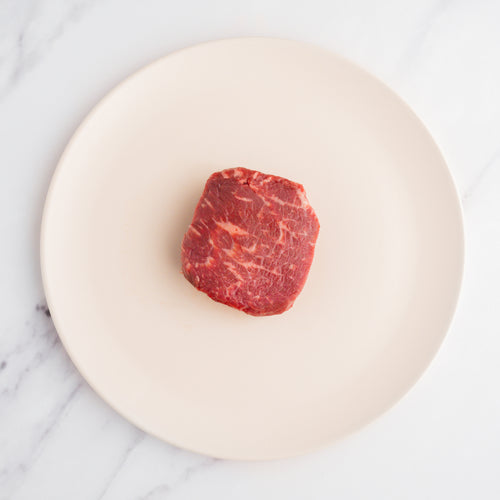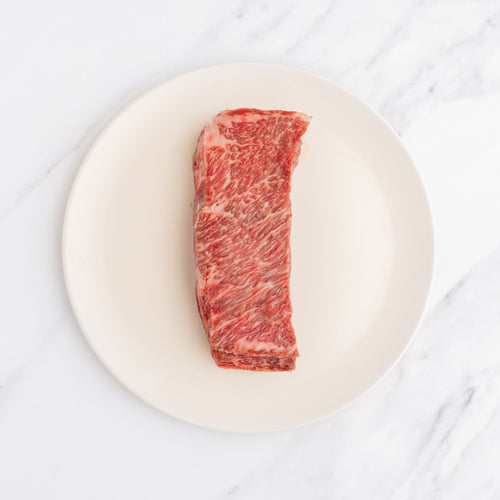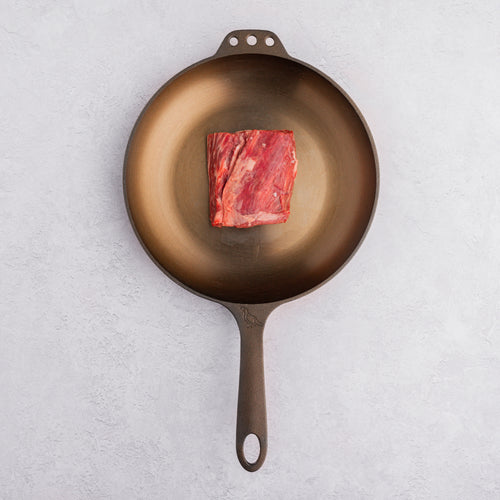
What Is Beef Marbling and How Does It Impact Flavor?
What’s the deal with beef marbling? Is it a real thing or a marketing gimmick? And what, exactly, does it have to do with the quality of meat and how your steaks taste?
At Snake River Farms, superior beef is our bread and butter. Here’s the lowdown on what beef marbling means and how it impacts the flavor of your SRF steaks and roasts.

What is Beef Marbling?
Marbling in beef refers to visible white streaks of intramuscular fat that run throughout the muscle tissue in any cut. The intramuscular fat in highly marbled beef liquifies when heated and provides a self-basting effect. The melted fat infuses the beef with a savory richness and velvety texture. Each bite of a well-marbled steak delivers extraordinary juiciness and robust flavor beyond compare.
Certain breeds of cattle naturally produce more intensely marbled beef, such as wagyu.
Intermuscular vs. Intramuscular Fat
Let’s talk about fat. There are two kinds of fat in cattle: intermuscular and intramuscular.
- Intermuscular fat— refers to those solid white chunks or strips of fat between the muscles. This is the fat you or your butcher trim off before cooking or eating because it doesn’t contribute to an elevated dining experience. If you’ve ever tried to eat cooked intermuscular fat, you understand why it’s the origin of the phrase “chew the fat.” It’s rubbery and, other than the charred exterior, can be unpleasant to eat.
- Intramuscular fat— on the other hand, occurs inside the muscle tissue. It’s those flecks and streaks of white you see scattered among the red parts of the meat. When we say marbling, this is what we’re talking about. The name comes from its resemblance to swirled color patterns in marble and other kinds of stone. We’ll get to know more about how it affects flavor in a moment.

Understanding Beef Marbling Score (BMS)
At Snake River Farms, we use the Beef Marbling Score (BMS) to measure the quality of our beef. BMS assigns a number between 1 and 12 to reflect a cut of meat’s level of intramuscular fat. Unlike the USDA grading system, BMS provides a clearer way to assess marbling in beef, allowing for a more detailed understanding of quality.
USDA Prime beef maxes out at a BMS of 5, while Snake River Farms American Wagyu beef can score as high as 12, offering unparalleled marbling, tenderness, and flavor.

What makes Wagyu Beef so Marbled?
Wagyu cattle are special because they naturally produce higher densities of intramuscular fat, creating richer flavor compared to regular beef. The marbling seen in cuts of Wagyu steaks ultimately comes down to genetics and how the cattle are raised. A skilled and experienced rancher can encourage higher levels of marbling through careful breeding and diet, ensuring that the beef’s quality surpasses typical standards.
Is Wagyu Fat Healthy?
The fat content of Wagyu beef is primarily made up of monounsaturated fat, which is considered a healthy type of fat. Monounsaturated fat is rich in vitamins and beneficial fatty acids and does not contribute to an increase in cholesterol. This is a contrast to the unhealthy fats found in processed foods.
While Wagyu fat is healthy, some find it difficult to finish a full cut of Wagyu steak served in a typical Western portion (i.e. 6 oz). The very high marbling levels in Wagyu create such richness that some may feel too full to finish the entire meal. That’s why American Wagyu beef, a cross between Japanese Wagyu and North American cattle, offers a balanced richness and flavor, making it easier to enjoy traditional steak cuts like cowboy ribeye, filet mignon, or even low-and-slow cooked brisket.

American Wagyu: Beyond Marbling Expectations
All Snake River Farms American Wagyu beef grades above USDA Prime. One of the unique qualities of Wagyu cattle is that they naturally produce more marbling than other breeds. Producing higher levels of marbling comes from the carefully controlled diet we feed our cattle, including local grass and other grains. But part of it is simply a genetic trait — which is why our founder gambled on importing Japanese Wagyu in the 1980s and crossbreeding them with domestic cattle.
Because our American Wagyu beef surpasses most other domestic beef in marbling, we developed four categories for our products by synthesizing the USDA and BMS systems:
- USDA Choice – BMS of 2 to 3. Great flavor and tenderness, above-average steaks.
- USDA Prime – BMS of 4 to 5. Includes only about 5% of all domestic beef.
- SRF Black® – BMS of 6 to 8. Superior to USDA Prime, with rich flavor and melt-in-your-mouth tenderness.
- SRF Gold® – BMS of 9–10. Rich flavor, buttery texture, and exceptional marbling.
-
SRF Gold Plus™ – BMS 11–12. The highest marbling available, offering unparalleled tenderness, richness, and flavor for the ultimate Wagyu experience.

Ready to Experience the Best in Beef?
Now that you know the differences in marbling and how it impacts flavor, it’s time to choose the perfect beef for your next meal. Whether you're looking for the tenderness of USDA Prime, the rich flavor of American Wagyu, or the luxurious experience of Gold Plus™, Snake River Farms has the perfect option for you.
USDA Choice & Prime
Enjoy tender, juicy beef that’s perfect for any meal. USDA Choice and Prime cuts provide rich flavor and texture, ideal for everything from everyday dinners to special celebrations.
Shop USDA Choice & Prime →American Wagyu Beef
Indulge in the unparalleled marbling and buttery flavor of American Wagyu. With exceptional tenderness and flavor, it's the perfect choice for those seeking a premium beef experience.
Shop American Wagyu →Wagyu Gold Plus™
Experience the ultimate in beef excellence with SRF Gold Plus™. Known for its rich marbling and melt-in-your-mouth texture, it’s the peak of American Wagyu flavor and tenderness.
Shop Gold Plus™ →






